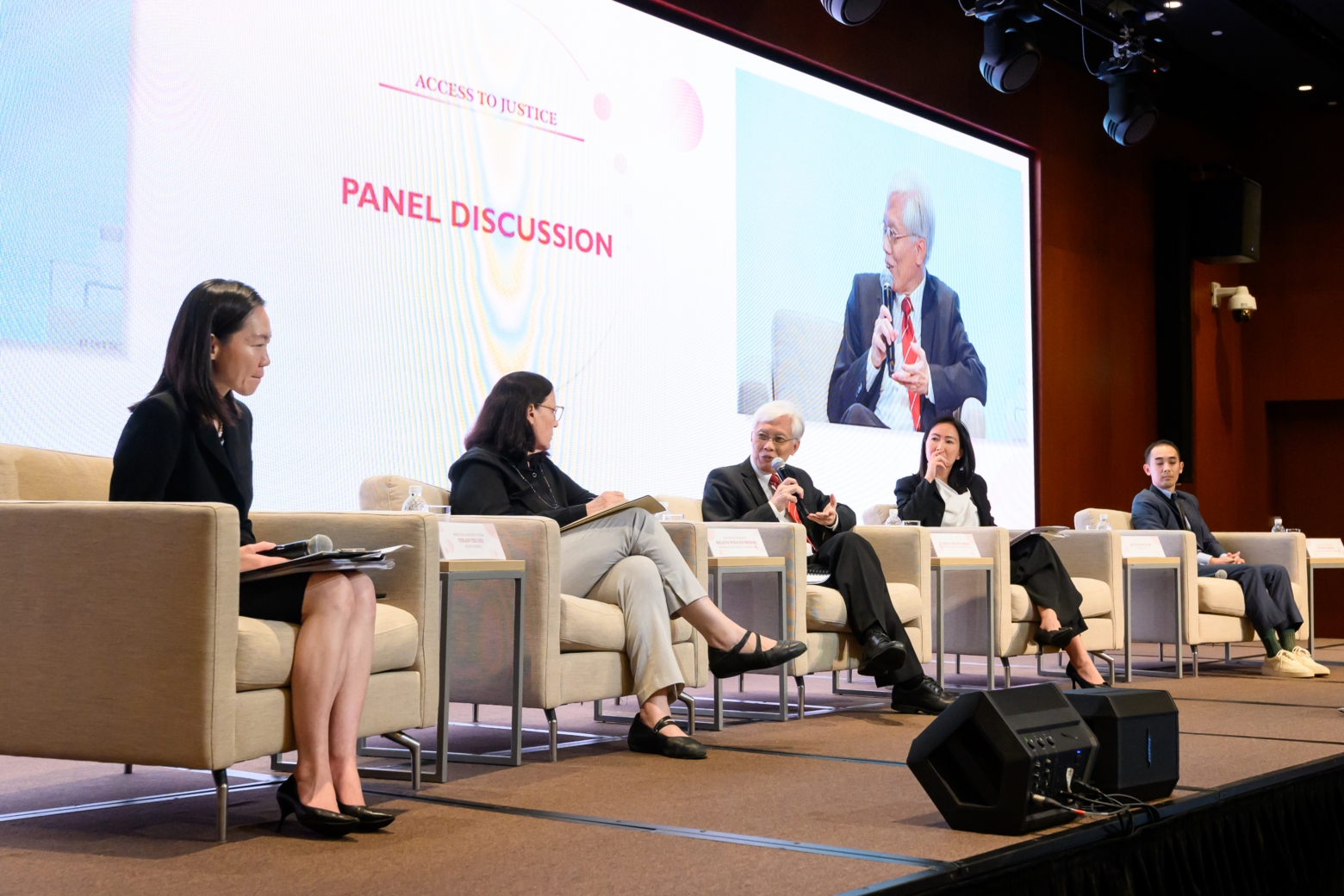BRANDED CONTENT
Navigating civil disputes: Initiatives that improve access to community justice
The courts are helping to bridge knowledge gaps and simplifying processes, as more people seek to represent themselves

Automated document assembly systems, for example, help users create court documents after they answer a series of questions.
PHOTO: GETTY IMAGES
Chen Rui, Content STudio
Follow topic:
Life can sometimes throw you curveballs: An unfair job loss, car accident or sudden eviction.
When these and other distressing situations happen, you may wonder: Is there anything the law can do to help me get justice?
It used to be that addressing these questions meant hiring a lawyer or facing a daunting do-it-yourself process.
First, you’d need to recognise what’s at stake before you can even file your claim. Do you have a legal interest to protect? Where do you go for that protection? Are you on the right path? What would you get if you are successful?
Even if you set off on the right path, representing yourself in court traditionally meant taking time out from work to draft documents, understand the legal processes, prepare for trial, and meet deadlines.
“All of this is a lot – a lot to understand, to manage, and to get through,” said Presiding Judge of the State Courts of Singapore, Justice Vincent Hoong.
He was speaking on Jan 24 at a Singapore Courts (SG Courts) event titled “Conversations with the Community”, an engagement series that brings together academia, legal and other sectors to forge multi-sector collaboration.
Justice Hoong observed that people involved in “community law” disputes – typically matters such as rental agreements, employment issues and family wills – are less likely to hire lawyers.
They may think the case is simple, and that the value of the dispute will be disproportionate to the claim. Increasingly, more also want to be self-reliant and believe they can get through the process with help from online resources.
How do the courts help enhance access to justice for the community? Watch the highlights of the third session of Conversations with the Community in this video below to find out more.
“Our (justice) system must not only be able to cope with this reality, but thrive in this new paradigm,” Justice Hoong said in his opening address. “It is not reasonable to expect the community to undergo a crash course on how to run a civil dispute, while managing their lives.
“A more effective way is to ensure that there are alternative, simpler processes for the community to get access to quality civil justice.”
Breaking down barriers
To do that, the courts aim to make community justice more accessible by reducing barriers to “knowing” and “doing” (see below).
One solution is automated document assembly systems, which help users create court documents after they answer a series of questions.
“The self-represented person can access the system with less stress,” said National University of Singapore Associate Professor of Law Helena Whalen-Bridge, at a panel discussion during the event. She notes that these systems are used in the US and Singapore.
“The lawyers on the opposing side are also seeing more focused, relevant documents,” she said.
Lawyers who use these systems free up time to pursue higher-value work for their clients. As a result, the community can benefit from lower legal costs, added Ms Vivienne Lim, founding director of Genesis Law Corporation and a board member of Pro Bono SG.
A more user-centric system
SG Courts has evolved from using systems previously designed with judges and lawyers in mind, to differentiated systems and processes that are more user-friendly and accessible to the community.
KNOWING: To enable with useful information
- Detailed self-help guides created by SG Courts (available on judiciary.gov.sg) break down legal information to help the community understand the processes for pursuing various types of claims, including lower value contractual claims, employment claims, claims relating to neighbour disputes, and claims for harassment.
- To make the information in these guides easier to understand, instructional videos will soon be available.
- While the courts cannot provide legal advice, they can help bridge the gap in legal literacy by letting the public know about free legal clinics operated by Pro Bono SG, and the on-site legal clinic in the Community Justice Centre (CJC), State Courts which provides free and immediate basic legal advice.
- The CJC-run Primary Justice Project charges a relatively low fixed fee to help the community explore settling certain types of disputes, without having to go to court.
DOING: To facilitate the community’s journey
- The end-to-end online Community Justice and Tribunals System guides users through the process of filing community claims and enables them to file and access documents online, manage their cases and conduct hearings without having to physically go to court, easing their administrative burden.
- Unlike typical civil proceedings, judges of the Small Claims Tribunals, Employment Claims Tribunals, Community Dispute Resolution Tribunals and Protection from Harassment Court take a judge-led approach, proactively guiding parties through the court procedure facilitating settlement, and driving the adjudication process.
- To level the playing field between parties to the dispute, the participation of lawyers in cases under these tribunals is restricted. If settlement fails, the judge-led approach taken in these specialist proceedings ensure that justice is delivered quickly and fairly.
- Since 2014, the Magistrates’ Courts have rolled out simplified proceedings that reduce pre-trial complexities and shorten trial duration to make them more manageable for self-represented persons. The simplified regime was extended to District Court proceedings last December.
Technology will also be critical in bridging the information and skills gaps to provide access to justice for all, particularly as Singapore faces a shortage of lawyers.
“Technology is non-negotiable, because that’s the only way we can scale,” said Mr Lim How Khang, Assistant Professor of Law and Computer Science at Singapore Management University.
But technologies that scale well – think Google’s search engine – require much effort to be designed, he added. “We really need to try a lot harder to figure out where technology can come in, because a lot has been done but we’re still very far behind what is possible.”

More on Singapore’s judiciary
- Access for all: Find legal processes and terms confusing? Navigating legal procedures is now simpler, thanks to digital tools and streamlined processes.
- Simplified language: Terms such as “ex parte” and “leave of court” will be replaced with “without notice” and “permission of the court” respectively at the Family Justice Courts, so they can be easily understood by the public.
- Helping families heal: Instead of bitter disputes, the Family Justice Courts aim to help parties in family disputes keep an open mind and work together to find the best solutions.
Looking ahead
“All told,” Justice Hoong said, “the courts have in place a foundationally sound and trusted system that can deliver quality civil justice to the community.” But the system does not remain static.
One example of this shift is increased emphasis on mediation in community law cases.
“Very often, the first port of call is really mediation,” said Justice Hoong. Coming to court “does not necessarily mean that there should be a ‘winner takes all’ outcome. We work very hard to find solutions that address the parties’ underlying interests, and not their strict legal rights”.
He added: “And that to me, is what access to justice is about: Both parties leaving the courthouse, feeling that their interests have been addressed.”
SG Courts has also set up an Access to Justice Programme Office to look into more ways to enhance people’s access to justice.
Some of the latest solutions SG Courts is exploring include a partnership with Harvey, a US-based artificial intelligence legal start-up, to create a pilot programme that helps self-represented people prepare for small claims cases.
“(The courts) will continue to identify improvements,” Justice Hoong said. “Such consistent and thoughtful iterations are the means by which we build on our strong foundations and improve the system’s trustworthiness even further.”
By the numbers
- $159 million
Between 2021 and 2023, around $129 million in small claims and $30 million in employment claims were filed in the Small Claims Tribunals and Employment Claims Tribunals respectively.
- > 34,000 cases
Number of claims filed in the Small Claims Tribunals, the Employment Claims Tribunals, the Community Dispute Resolution Tribunals and the Protection from Harassment Court, between 2021 and 2023. In particular, the Small Claims Tribunals see over 12,000 cases filed each year.
- 4 to 6 months
The majority of claims at the Small Claims Tribunals are resolved within four months, while the bulk of claims at the Employment Claims Tribunals are resolved within six months.
Register your interest for upcoming sessions of “Conversations with the Community” by emailing conversations@judiciary.gov.sg. Visit www.judiciary.gov.sg for more details.
In partnership with SG Courts

